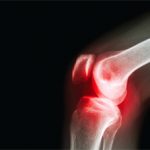Injections & Other Drugs
In a 2015 Cochrane review, intra-articular corticosteroids compared with placebo for knee OA pain had a small effect size of 0.3.12 Repeat injections significantly reduced cartilage thickness, according to a 2017 study, possibly because patients “felt so much better.13 They were much more active and they damaged their cartilage,” he said. “This doesn’t have anything to do with the effects of the steroid on cartilage. It has to do with the effect of activity on these knees.” Dr. Felson injects 80 mg of corticosteroids into the knees of his OA patients or 40 mg for diabetic patients, he said.
Intra-articular hyaluronic acid injections are ineffective for knee OA, although some patients may feel relief due to the placebo effect, he said.14 Glucosamine and chondroitin sulfate, although popular, also do not relieve OA knee pain.15 Opioids also do not work well for knee OA pain relief; a recent meta-analysis shows that opioids’ effect size is 0.36.16
Tanezumab, a humanized monoclonal antibody to nerve growth factor that targets the peripheral nerves, had an effect size of 0.8 in a 2010 randomized controlled trial, but the trial was stopped when patients in the active treatment group had rapid disease progression, likely due to overdoing physical activity when their pain subsided.17
Nondrug Strategies
Braces are effective treatments for malaligned joints, and in a 2015 meta-analysis, their effect size was 0.33.18 “Why are braces not the most popular treatment? The answer is that many patients won’t wear them or wear them for three hours a day or less,” he said. Suggest an over-the-counter knee brace before referring a patient to an orthotics specialist for a fitted brace due to the high cost, he suggested.
Exercise is also effective for knee pain, and if a patient is overweight, exercise with diet modification is even more effective, he said.19 He encourages his patients to do gentle squats at increasing depth as long as they are not in pain. “Exercise needs to be progressive,” he said. “You need to reinforce that with your patients.”
Susan Bernstein is a freelance medical journalist based in Atlanta.
References
- Felson DT, Niu J, McClennan C, et al. Knee buckling: Prevalence, risk factors, and associated limitations in function. Ann Intern Med. 2007 Oct 16;147(8):534–540.
- Zhang Y, Nevitt M, Niu J, et al. Fluctuation of knee pain and changes in bone marrow lesions, effusions and synovitis on magnetic resonance imaging. Arthritis Rheum. 2011 Mar;63(3):691–699.
- Felson DT, Chaisson CE, Hill CL, et al. The association with bone marrow lesions with pain in knee osteoarthritis. Ann Intern Med. 2001 Apr 3;134(7):541–549.
- Hill CL, Gale DR, Chaisson CE, et al. Periarticular lesions detected on magnetic resonance imaging: Prevalence in knees with and without symptoms. Arthritis Rheum. 2003 Oct;48(10):2836–2844.
- Felson DT, McLaughlin S, Goggins J, et al. Bone marrow edema and its relation to progression of knee osteoarthritis. Ann Intern Med. 2003 Sep 2;139(5 Pt. 1):330–336.
- Hochberg MC, Altman RD, April KT, et al. American College of Rheumatology 2012 recommendations for the use of nonpharmacologic and pharmacologic therapies for osteoarthritis of the hand, hip, and knee. Arthritis Care Res (Hoboken). 2012 Apr;64(4):465–474.
- Neame R, Zhang W, Doherty M. A historic issue of the Annals: Three papers examine paracetamol in osteoarthritis. Ann Rheum Dis. 2004 Aug;63(8):897–900.
- Verkleij SP, Luijsterburg PA, Bohnen AM, et al. NSAIDs vs acetaminophen in knee and hip osteoarthritis: A systematic review regarding heterogeneity influencing the outcomes. Osteoarthritis Cartilage. 2011 Aug;19(8):921–929.
- Antman EM. Evaluating the cardiovascular safety of non-steroidal anti-inflammatory drugs. Circulation. 2017 May 23;135(21):2062–2072.
- Huang JQ, Sridhar S, Hunt RH. Gastrointestinal safety profile of nabumetone: A meta-analysis. Am J Med. 1999 Dec 13;107(6A):55S–61S.
- Nissen SE, Yeomans ND, Solomon DH, et al. Cardiovascular safety of celecoxib, naproxen, or ibuprofen for arthritis. N Engl J Med. 2016 Dec 29;375(26):2519–2529.
- Jüni P, Hari R, Rutjes AWS, et al. Intra-articular corticosteroid for knee osteoarthritis. Cochrane Database Syst Rev. 2015 Oct 22;(10):CD005328.
- McAlindon TE, LaValley MP, Harvey WF, et al. Triamcinolone vs saline on knee cartilage volume and pain in patients with knee osteoarthritis: A randomized clinical trial. JAMA. 2017 May 16;317(19):1967–1975.
- Lo GH, LaValley MP, McAlindon TE. Intra-articular hyaluronic acid in treatment of knee osteoarthritis: A meta-analysis. JAMA. 2003 Dec 17;290(23):3115–3121.
- Vlad SC, LaValley MP, McAlindon TE, Felson DT. Glucosamine for pain in osteoarthritis: Why do trial results differ? Arthritis Rheum. 2007 Jul;56(7):2267–2277.
- da Costa BR, Nüesch E, Kasteler R, et al. Oral or transdermal opioids for osteoarthritis of the knee or hip. Cochrane Database Syst Rev. 2014;9:CD003115.
- Lane NE, Schnitzer TJ, Birbara CA, et al. Tanezumab for the treatment of pain from osteoarthritis of the knee. New Engl J Med. 2010 Oct 14;363(16):1521–1531.
- Moyer RF, Birmingham TB, Bryant DM, et al. Valgus bracing for knee osteoarthritis: A meta-analysis of randomized trials. Arthritis Care Res (Hoboken). 2015 Apr;67(4):493–501.
- Messier SP, Loeser RF, Miller GD, et al. Exercise and dietary weight loss in overweight and obese older adults with knee osteoarthritis: The Arthritis, Diet, and Activity Promotion Trial. Arthritis Rheum. 2004 May;50(5):1501–1510.

